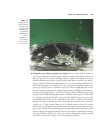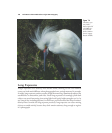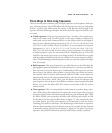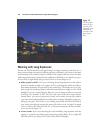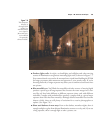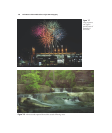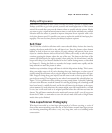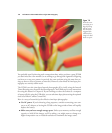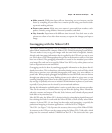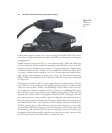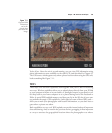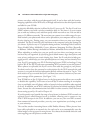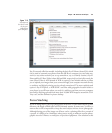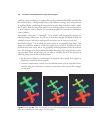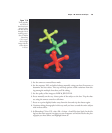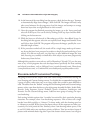
■ Make a movie. While time-lapse stills are interesting, you can increase your fun
factor by compiling all your shots into a motion picture using your favorite desk-
top movie-making software.
■ Protect your camera. Make sure your camera is protected from weather, earth-
quakes, animals, young children, innocent bystanders, and theft.
■ Vary intervals. Experiment with different time intervals. You don’t want to take
pictures too often or less often than necessary to capture the changes you hope to
image.
Geotagging with the Nikon GP-1
The Nikon product line gained a lot of credibility as a tool for serious photographers
when Nikon introduced the compact Nikon GP-1 Global Positioning System device.
The unit makes it easy to tag your images with the same kind of longitude, latitude,
altitude, and time stamp information that is supplied by the GPS unit you use in your
car. (Don’t have a GPS? Photographers who get lost in the boonies as easily as I do must
have one of these!) The geotagging information is stored in the metadata space within
your image files, and can be accessed by Nikon View NX2, or by online photo services
such as mypicturetown.com and Flickr.
Geotagging can also be done by attaching geographic information to the photo after it’s
already been taken. This is often done with online sharing services, such as Flickr, which
allow you to associate your uploaded photographs with a map, city, street address, or
postal code. When properly geotagged and uploaded to sites like Flickr, users can browse
through your photos using a map, finding pictures you’ve taken in a given area, or even
searching through photos taken at the same location by other users. Of course, in this
day and age it’s probably wise not to include GPS information in photos of your home,
especially if your photos can be viewed by an unrestricted audience.
Having this information available makes it easier to track where your pictures are taken.
That can be essential, as I learned from a trip out West this Spring, where I found the
red rocks, canyons, and arroyos of Nevada, Utah, Arizona, and Colorado all pretty much
look alike to my untrained eye.
Like all GPS units, the Nikon GP-1 obtains its data by triangulating signals from satel-
lites orbiting the Earth. It works with the Nikon D7000, as well as many other Nikon
cameras. At about $225, it’s not cheap, but those who need geotagging—especially for
professional mapping or location applications—will find it to be a bargain.
The GP-1 (see Figure 7.10) slips onto the accessory shoe on top of the Nikon D7000.
It connects to the GPS port on the camera using the Nikon GP1-CA90 cable, which
plugs into the connector marked CAMERA on the GP-1. The device also has a port
Chapter 7 ■ Advanced Techniques 193



